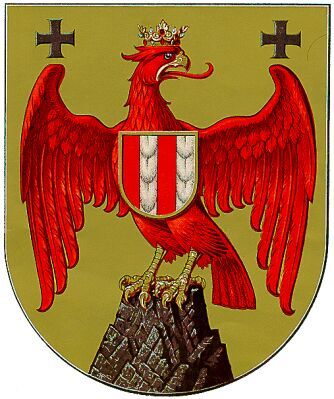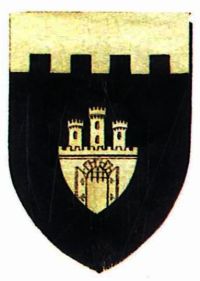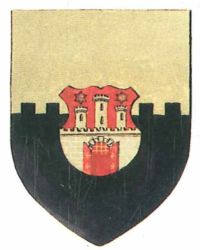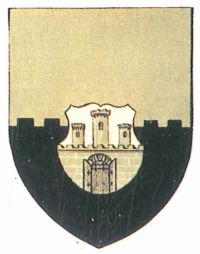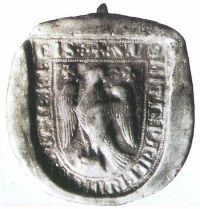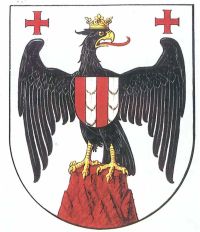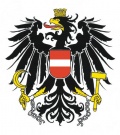Burgenland: Difference between revisions
Knorrepoes (talk | contribs) m (Text replacement - "{{at}}↵↵'''" to "'''") |
Knorrepoes (talk | contribs) m (Text replacement - " :" to ":") |
||
| Line 36: | Line 36: | ||
{{media}} | {{media}} | ||
[[Civic Heraldry Literature - Austria|Literature]] : Prickle, 2001 | [[Civic Heraldry Literature - Austria|Literature]]: Prickle, 2001 | ||
[[Category:Austria]] | [[Category:Austria]] | ||
[[Category:Burgenland]] | [[Category:Burgenland]] | ||
[[Category:Granted 1922]] | [[Category:Granted 1922]] | ||
Latest revision as of 11:10, 28 July 2024
BURGENLAND
Official blazon
- (de) Ein goldener Schild, in welchem ein sich zum Fluge anschickender, widersehender, roter, golden gekrönter, ebenso bewehrter, rotbezungter Adler auf einem sich aus dem Fußrande des Schildes erhebenden schwarzen Felsen steht. Die Brust des Adlers ist mit einem dreimal von Rot und Kürsch gespaltenen, mit einer schmalen goldenen Randeinfassung versehenen Schildchen belegt, seine Flügelknochen sind in den beiden Oberecken des Schildes von je einem breitendigen schwarzen Kreuzchen überhöht.
Origin/meaning
The arms were officially granted in 1922.
Burgenland was created in 1918 from the German-speaking areas of former Hungarian territories. In 1919 it was transferred from Hungary to Austria.
The arms were created in 1922. The arms are a combination of the arms of the two most powerful families in the area in medieval times. The eagle with crosses is derived from the arms of the Counts of Mattersdorf-Forchtenstein, the breast shield from the arms of the Counts of Güssing-Bernstein.
The first attempts for arms for the new state were designed in 1919 by Major August Polten. In his designs he incorporated a canting element (Burg=castle) with am embattled chief, and as an addition he placed the castle taken from the arms of Ödenburg, the capital to be.
| Proposal 1 from 1919 |
Proposal 2 from 1919 |
| Proposal 3 from 1919 |
These proposals were never approved by the temporary government and not taken into consideration when the new State was finally established. In addition, the proposed capital, Ödenburg voted to remain part of Hungary as Sopron and its castle could obviously no longer be part of the State arms.
In 1922 the Institut für Genealogie, Familienrecht und Wappenkunde in Vienna was asked to make a new design. Initially the idea was to incorporate elements from the arms of the Hungarian Comitate from which the new State was created. But, as these were of poor heraldic quality and remained in existence in Hungary, this would cause too much confusion and the proposal was abolished. Finally Alfred Anthony von Siegenfeld from the institute decided on the use of arms of important regional families. He decided on the Counts of Mattersdorf-Forchtenstein and Von Güssing. The main field would be the eagle of Mattersdorf, with an inescutcheon of Güssing. The colours were silver and black.
| Seal of Count Paul von Mattersdorf (14th century) |
Proposal from 1922 |
The new State parliament approved in 1922 the design, but also decided on colours for the new State. Besides the arms above, also green and red were proposed as colours, but the new parliament decided on the colours gold and red. These were, supposedly, commonly used colours in the area. Accordingly the field of the arms was changed from silver to gold and the arms have not changed since. Although the image was approved, the legal issues on the description and use were not properly cleared until the 1990s.
Austria heraldry portal
This page is part of the Austria heraldry portal |
Heraldry of the World |
|
Civic heraldry:
|
Other heraldry: |
Contact and Support
Partners:
Your logo here ?
Contact us
© since 1995, Heraldry of the World, Ralf Hartemink 
Index of the site
Literature: Prickle, 2001
